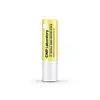What's inside
What's inside
 Key Ingredients
Key Ingredients

 Benefits
Benefits

 Concerns
Concerns

 Ingredients Side-by-side
Ingredients Side-by-side

Hydrogenated Polyisobutene
EmollientPhytosteryl/Isostearyl/Cetyl/Stearyl/Behenyl Dimer Dilinoleate
Skin ConditioningHydrogenated Poly(C6-14 Olefin)
EmollientDiisostearyl Malate
EmollientEthylene/Propylene/Styrene Copolymer
Butyrospermum Parkii Butter
Skin ConditioningSynthetic Wax
AbrasiveButylene/Ethylene/Styrene Copolymer
Parfum
MaskingPolyglyceryl-2 Triisostearate
EmulsifyingEthylhexylglycerin
Skin ConditioningCI 45410
Cosmetic ColorantCI 16035
Cosmetic ColorantCI 77891
Cosmetic ColorantPentaerythrityl Tetra-Di-T-Butyl Hydroxyhydrocinnamate
AntioxidantCI 77499
Cosmetic ColorantTocopherol
AntioxidantWater
Skin ConditioningButylene Glycol
Humectant1,2-Hexanediol
Skin ConditioningHydrolyzed Extensin
Skin ConditioningSodium Dna
Skin ConditioningRosa Damascena Flower Extract
MaskingDisodium EDTA
Acetyl Hexapeptide-8
HumectantHydrogenated Polyisobutene, Phytosteryl/Isostearyl/Cetyl/Stearyl/Behenyl Dimer Dilinoleate, Hydrogenated Poly(C6-14 Olefin), Diisostearyl Malate, Ethylene/Propylene/Styrene Copolymer, Butyrospermum Parkii Butter, Synthetic Wax, Butylene/Ethylene/Styrene Copolymer, Parfum, Polyglyceryl-2 Triisostearate, Ethylhexylglycerin, CI 45410, CI 16035, CI 77891, Pentaerythrityl Tetra-Di-T-Butyl Hydroxyhydrocinnamate, CI 77499, Tocopherol, Water, Butylene Glycol, 1,2-Hexanediol, Hydrolyzed Extensin, Sodium Dna, Rosa Damascena Flower Extract, Disodium EDTA, Acetyl Hexapeptide-8
Phytosteryl/Isostearyl/Cetyl/Stearyl/Behenyl Dimer Dilinoleate
Skin ConditioningPolyglyceryl-2 Triisostearate
EmulsifyingDipentaerythrityl Hexa C5-9 Acid Esters
Skin ConditioningHydrogenated Polyisobutene
EmollientDiphenylsiloxy Phenyl Trimethicone
Skin ConditioningMacadamia Seed Oil Polyglyceryl-6 Esters Behenate
EmollientCeresin
Emulsion StabilisingSynthetic Wax
AbrasiveCaprylic/Capric Triglyceride
MaskingEthylene/Propylene Copolymer
AbrasiveMicrocrystalline Wax
Emulsion Stabilising1,2-Hexanediol
Skin ConditioningDimethicone
EmollientMyristica Fragrans Extract
MaskingDiisostearyl Malate
EmollientCI 77891
Cosmetic ColorantButylene Glycol
HumectantTocopherol
AntioxidantWater
Skin ConditioningCI 77492
Cosmetic ColorantPropolis Extract
Skin ConditioningPhytosteryl/Isostearyl/Cetyl/Stearyl/Behenyl Dimer Dilinoleate, Polyglyceryl-2 Triisostearate, Dipentaerythrityl Hexa C5-9 Acid Esters, Hydrogenated Polyisobutene, Diphenylsiloxy Phenyl Trimethicone, Macadamia Seed Oil Polyglyceryl-6 Esters Behenate, Ceresin, Synthetic Wax, Caprylic/Capric Triglyceride, Ethylene/Propylene Copolymer, Microcrystalline Wax, 1,2-Hexanediol, Dimethicone, Myristica Fragrans Extract, Diisostearyl Malate, CI 77891, Butylene Glycol, Tocopherol, Water, CI 77492, Propolis Extract
 Reviews
Reviews

Ingredients Explained
These ingredients are found in both products.
Ingredients higher up in an ingredient list are typically present in a larger amount.
1,2-Hexanediol is a synthetic liquid and another multi-functional powerhouse.
It is a:
- Humectant, drawing moisture into the skin
- Emollient, helping to soften skin
- Solvent, dispersing and stabilizing formulas
- Preservative booster, enhancing the antimicrobial activity of other preservatives
Butylene Glycol (or BG) is used within cosmetic products for a few different reasons:
Overall, Butylene Glycol is a safe and well-rounded ingredient that works well with other ingredients.
Though this ingredient works well with most skin types, some people with sensitive skin may experience a reaction such as allergic rashes, closed comedones, or itchiness.
Learn more about Butylene GlycolCi 77891 is a white pigment from Titanium dioxide. It is naturally found in minerals such as rutile and ilmenite.
It's main function is to add a white color to cosmetics. It can also be mixed with other colors to create different shades.
Ci 77891 is commonly found in sunscreens due to its ability to block UV rays.
Learn more about CI 77891Diisostearyl Malate is an emollient and most often used in lip products. It comes from isostearyl alcohol, a fatty acid, and malic acid, an AHA.
As an emollient, Diisostearyl Malate helps create a thin film on your skin to trap moisture in. This helps keep your skin soft and smooth.
Hydrogenated Polyisobutene is a synthetic polymer. Polymers are compounds with high molecular weight. Hydrogenated Polyisobutene is an emollient and texture enhancer.
In one study, Hydrogenated Polyisobutene showed better skin hydration levels than Caprylic/Capric Triglyceride. As an emollient, it helps keep your skin soft and hydrated by trapping moisture in.
Hydrogenated Polyisobutene is often used as a mineral oil replacement.
Learn more about Hydrogenated PolyisobuteneWe don't have a description for Phytosteryl/Isostearyl/Cetyl/Stearyl/Behenyl Dimer Dilinoleate yet.
This ingredient is a form of glycerin with emulsifying and emollient properties.
As an emulsifier, this ingredient helps keep products together while adding a thick texture. The manufacturer states this ingredient has emollient properties. Emollients help keep the skin hydrated by trapping moisture in.
Polyglyceryl-2 Triisostearate is created by reacting diglycerin and isostearic acid. Due to the isostearic acid base, it may not be safe for Malassezia or fungal acne.
Learn more about Polyglyceryl-2 TriisostearateSynthetic Wax is created from fossil fuels such as natural gas. It is used to enhance texture, adjust pH, and as an occlusive.
It may also be used as an abrasive ingredient to exfoliate the skin.
Synthetic Wax may not be fungal acne safe.
Learn more about Synthetic WaxTocopherol (also known as Vitamin E) is a common antioxidant used to help protect the skin from free-radicals and strengthen the skin barrier. It's also fat soluble - this means our skin is great at absorbing it.
Vitamin E also helps keep your natural skin lipids healthy. Your lipid skin barrier naturally consists of lipids, ceramides, and fatty acids. Vitamin E offers extra protection for your skin’s lipid barrier, keeping your skin healthy and nourished.
Another benefit is a bit of UV protection. Vitamin E helps reduce the damage caused by UVB rays. (It should not replace your sunscreen). Combining it with Vitamin C can decrease sunburned cells and hyperpigmentation after UV exposure.
You might have noticed Vitamin E + C often paired together. This is because it is great at stabilizing Vitamin C. Using the two together helps increase the effectiveness of both ingredients.
There are often claims that Vitamin E can reduce/prevent scarring, but these claims haven't been confirmed by scientific research.
Learn more about TocopherolWater. It's the most common cosmetic ingredient of all. You'll usually see it at the top of ingredient lists, meaning that it makes up the largest part of the product.
So why is it so popular? Water most often acts as a solvent - this means that it helps dissolve other ingredients into the formulation.
You'll also recognize water as that liquid we all need to stay alive. If you see this, drink a glass of water. Stay hydrated!
Learn more about Water